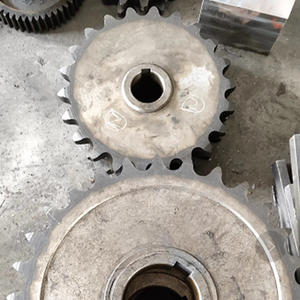The aluminum ingot casting machine solves the problems of easy delamination and falling off caused by the lax aluminum wrapping of iron particles, and effectively improves the efficiency of aluminum ingot casting, wrapping iron particles, demoulding, etc., and improves the quality of the product. So that it can fully meet the requirements of steelmaking production for the quality of aluminum ingots.

The aluminum ingot casting machine has simple structure, light and quick operation, does not occupy a lot of land, and is easy to move, which can effectively reduce the labor intensity of workers and improve the working environment.
Common faults of aluminum ingot casting machine and their troubleshooting methods:
1. The casting machine cannot be started. The following conditions must be met to start the motor of the casting machine: the proximity switches CK1 and CK2 on the two printing arms input signals to the PLC; The normally closed contact FR of the relay inputs a signal to the PLC; when the start button SB is pressed, it inputs a signal to the PLC. Therefore, the troubleshooting of this fault should check whether the components and circuits are in good condition one by one from the above four aspects:
2. The oil pump, oil circulation, and finished product conveyor motor cannot be started. As shown in Figure 2, the following three conditions must be met to start the three motors: the main circuit air switch is closed, the normally open point of the auxiliary contact Q becomes the normally closed point to give an input signal to the PLC; the normally closed contact of the thermal relay FR gives an input signal to PLC; when the start button SB is pressed, it gives an input signal to PLC. Therefore, to troubleshoot, it is necessary to check whether the components and circuits are in good condition from the above three aspects.
3. The cooling conveyor is not in place. Check whether its in-position proximity switch and circuit are in good condition; check whether the electromagnetic reversing valve of its oil cylinder and its circuit are in good condition.
4. The fixture trolley does not descend after it advances in place. Check whether the proximity switch of the clamp trolley advances in place, the solenoid valve of the clamp trolley down and their circuits are in good condition.
5. The clamp cannot be opened after the clamp trolley descends. There are two reasons for this fault. One is that there is a problem with the ground wire that controls the opening of the fixture, and the other is that there is a problem with the circuit board of the contact controller that controls the opening of the fixture. Therefore, it is necessary to eliminate this fault from the above two aspects.
6. After the jig trolley moves forward, the jig does not drop, and it will retreat immediately after opening. There may be two reasons for this fault: one is that the grounding wire on the circuit board of the contact controller that controls the opening of the fixture is grounded; the other is that the fixture trolley moves forward and the fixture is lowered and the proximity switch operates.
7. The ladle drops suddenly during the operation of the unit. According to the design requirements, any failure of the cooler, casting machine, or printing arm will cause the ladle to drop. Therefore, to troubleshoot this fault, it is necessary to check one by one from the above three aspects.
8. There is no deceleration when the jig trolley moves forward or backward. The adjustment of the deceleration of the fixture trolley is controlled by the deceleration potentiometer and the controller of the hydraulic flow speed regulating valve. In addition, it is also related to the deceleration proximity switch. Therefore, the troubleshooting of this fault should be checked one by one according to the factors mentioned above.
9. The entire unit suddenly loses power during operation, and the error indicator light on the CPU of the PLC appears to be faulty. Generally, it is impossible to start. It is recommended to check the power supply, grounding wire, external wires, and components of the PLC first. If there is no problem, check the PLC itself, and check the data cables between each module and the rack. The author once encountered this fault during the maintenance process. After confirming that the external lines were correct, the fault was finally eliminated by replacing the data cables between the racks.
The above is the "common faults of aluminum ingot casting machine and their troubleshooting methods". In the daily use of aluminum ingot casting machine, we must check and repair frequently, and repair the faults in time, so that aluminum ingot casting can be better used machine.
 English
English  Español
Español  Português
Português  русский
русский  français
français  日本語
日本語  Deutsch
Deutsch  Tiếng Việt
Tiếng Việt  Italiano
Italiano  Nederlands
Nederlands  ไทย
ไทย  Polski
Polski  한국어
한국어  Svenska
Svenska  Malay
Malay  বাংলা
বাংলা  हिन्दी
हिन्दी  Pilipino
Pilipino  Türk
Türk  عربى
عربى  Indonesia
Indonesia  norsk
norsk  čeština
čeština  Українська
Українська  Javanese
Javanese  فارسی
فارسی  తెలుగు
తెలుగు  Burmese
Burmese  български
български  Latine
Latine  Azərbaycan
Azərbaycan  Српски
Српски  Esperanto
Esperanto  Afrikaans
Afrikaans  Català
Català  Cymraeg
Cymraeg  Беларус
Беларус  Hrvatski
Hrvatski  Kreyòl ayisyen
Kreyòl ayisyen  Shqiptar
Shqiptar  Bosanski
Bosanski  Кыргыз тили
Кыргыз тили  ಕನ್ನಡ
ಕನ್ನಡ  IsiXhosa
IsiXhosa  Chichewa
Chichewa  Somali
Somali  O'zbek
O'zbek  հայերեն
հայերեն  Sundanese
Sundanese  Malagasy
Malagasy 






